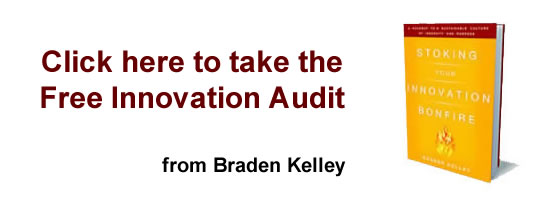Idea Challenges – You Get What You Give

In contradiction to what many people think, Idea Challenges are not about getting, they are about giving. Your employees will not automatically start sharing great, useful and relevant ideas to your organisational needs. As an organisation, you must give a lot before you get anything at all. And I do not mean prizes or money.
In this blogpost I will describe a number of important elements that you must give attention to when doing an ‘idea Challenge’ amongst your employees. The extend to how much attention you give each of the elements, is a strong determinant for your initiative’s success.
Give support: Senior management
The first thing you should have covered when starting an Idea Challenge is to have the support from senior management or equivalent. If your CEO does not agree with this new method of gathering ideas or the fact that all employees will be spending some time on this activity, you are very likely not going to succeed. If you can get senior management to endorse the initiative to all employees, you are half way to a successful Challenge.
Give a reason: Relevant Challenge theme
When your organisation starts an Idea Challenge, you will get a lot of input from your crowd. Therefore you should always have a good reason to start an Idea Challenge in order for the input to be useful. Do not start a Challenge simply because your competitor is doing one amongst its employees too. You will have to give your crowd a good reason why you are looking for ideas and how these will help everyone. Relevant themes for Idea Challenges are typically deducted from your innovation domains or your organisation’s strategic goals.
Give a promise: Challenge sponsorship
When asking your employees for ideas, there must be someone requesting the ideas; this is the Challenge sponsor. The Challenge sponsor must promise that the crowd’s efforts will not be for nothing and that the ideas will all be taken seriously and some will be further developed. The best way to do this is to show trust in the crowd by already stating in advance that budget will be allocated and the best idea(s) will be further developed.
Give information: Challenge information
Somewhere during the process you will need to inform the crowd what the challenge is about, what you are and what you are not looking for, what the overall process will be like, how ideas will be evaluated etc. By communicating all these steps in advance will give the crowd confidence that this time, they are being taken seriously. If these aspects are not communicated clearly, or your crowd does not have enough information on what you are looking for, you will not only get many irrelevant and useless ideas you will also disappoint your crowd by not using their input eventually. The Challenge question is the element that will be communicated mostly throughout the crowd. This question must be triggering for people to be willing to participate, it must be broad to allow for diversity of ideas but not to broad to spark irrelevant and useless ideas.
Give an example: Supporting Challenge team
The Challenge team is there to streamline dialogues, activate the crowd and stimulate the growth of ideas. They are an essential element in the success of an Idea Challenge. They take the role of the first follower in order to stimulate activity to the tipping point for Challenge participation as well as idea enrichment.
Give a tool: User-friendly and intuitive software
Obviously you must have a tool in place on which your crowd will be sharing their ideas and knowledge with each other. Giving your crowd a user-friendly and intuitive platform will lower the barrier for participation and increase participation and will raise the number of ideas. The more people you have participating in the Idea Challenge, the more valuable it can become. Well designed ideation tools should allow everyone within your target group to participate without obstacles. Well designed software should not only support high quantity of ideas by lowering participation barriers but also support increasing the quality of ideas. Idea Challenge software suggests other contributors to ideas and allows for active crowd management. A low barrier of participation and high user involvement will be another step forward to a successful outcome.
Give arguments: Idea evaluation
An important element of the idea Challenge is to evaluate all the ideas based upon predetermined criteria. Because you presumably cannot develop all the ideas that arose from the Challenge, you will need to make a well-founded decision on which ideas to pursue and which ideas are going to be put on the shelve. Without sensible arguments on why certain ideas go through to the next phase and why others don’t, you will loose the crowd’s moral and motivation for upcoming initiatives so be clear and transparent in this step.
Give action: Follow up of ideas
Your employees have been putting a lot of effort in their contributions. Your crowd has been very dedicated and they have not only kept to working hours. They have been active during the week, but they might have also submitted ideas late at night and enriched other’s ideas during the weekend. Therefore you must always give a lot of attention following up the ideas.
Give a story: Communication
One of the most important elements is a solid communication plan. It endorses many of the above mentioned elements. A well thought through and executed communication plan will play a major role in making the Idea Challenge a success.
Get your success
If all of the above elements are given enough attention and you have a dedicated and enthusiastic team, chances are high you will get a successful Idea Challenge. You will probably not only get many great and useful ideas but you will also get a lot of highly motivated employees who are feeling part of the innovation process and taken seriously. You have just created a sustainable crowd, one that you have earned the favor of asking them for input on more challenges.
Wait! Before you go.
Choose how you want the latest innovation content delivered to you:
- Daily — RSS Feed — Email — Twitter — Facebook — Linkedin Today
- Weekly — Email Newsletter — Free Magazine — Linkedin Group
 As innovation consultant, Jan Martijn Everts has facilitated more than 60 online idea challenges for a wide range of organisations and he has a lot of experience at community management. While working at the largest Dutch telecom operator, KPN, he has learned how to get things done in a large and complex organisation. Nowadays he is focusing on the Agile transformation of a large department and the new innovation process that it requires.
As innovation consultant, Jan Martijn Everts has facilitated more than 60 online idea challenges for a wide range of organisations and he has a lot of experience at community management. While working at the largest Dutch telecom operator, KPN, he has learned how to get things done in a large and complex organisation. Nowadays he is focusing on the Agile transformation of a large department and the new innovation process that it requires.
NEVER MISS ANOTHER NEWSLETTER!
LATEST BLOGS
How Brexit Has Affected UK E-commerce Businesses
Photo by Zyro on Unsplash The popularity of online shopping was already growing at an impressive rate – and…
Read MoreOvercoming range anxiety: three tips for EV owners
Photo by Jenny Ueberberg on Unsplash In the last few years, electric vehicles (EVs) have become more and more…
Read More


